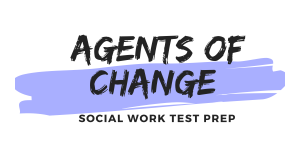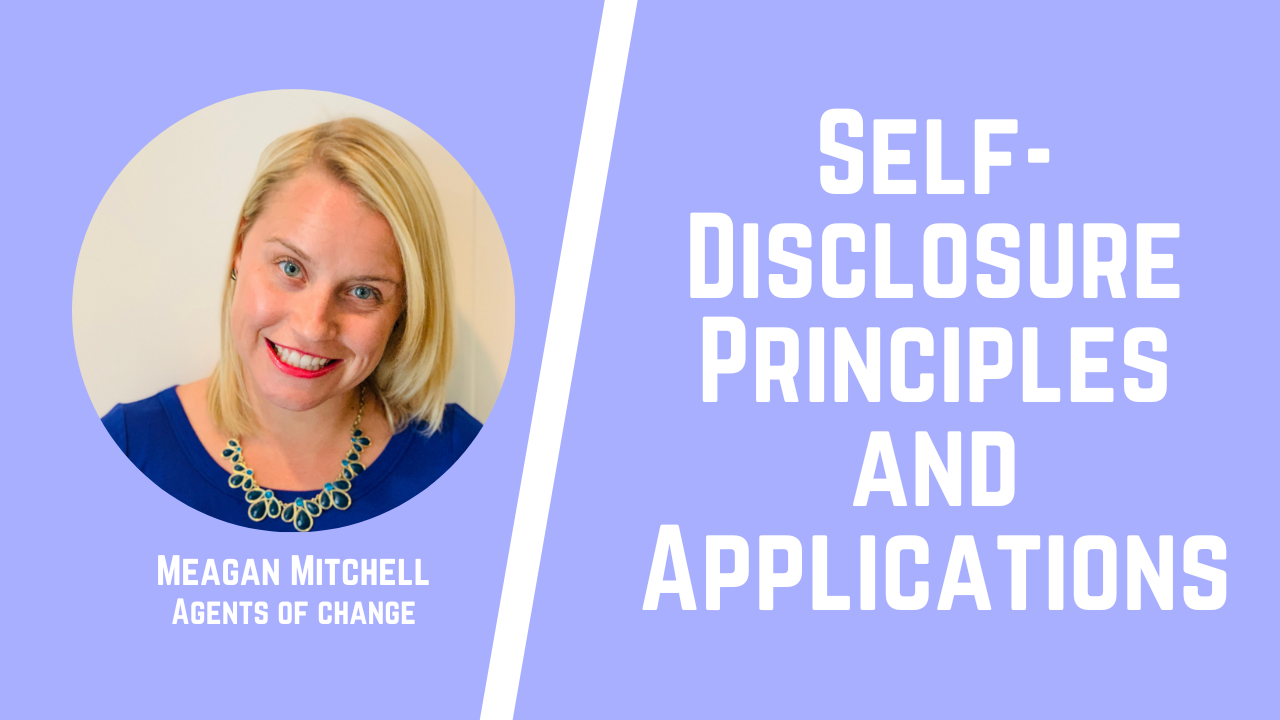Self-disclosure plays a pivotal role in bridging the chasm between theory and practice in Social Work, especially as you prepare for the ASWB exam. This blog post is your guide, illuminating the often complex and nuanced principles of self-disclosure and its practical applications in Social Work.
We’ll explore the what, the why, and the how of using self-disclosure to forge stronger, more therapeutic relationships with clients. Whether you’re a seasoned practitioner brushing up on your skills or a new Social Worker with eyes set on passing the ASWB exam, this guide will demystify the concept of self-disclosure and arm you with the knowledge and strategies you need to succeed.
Learn more about the ASWB exam and create a personalized ASWB study plan with Agents of Change. We’ve helped thousands of Social Workers pass their ASWB exams and want to help you be next!
1) What is Self-Disclosure and Why is it Important?
Self-disclosure is the process of revealing personal, private information about oneself to others. This concept plays an important role in everyday social interactions but holds particular significance in the field of Social Work and therapeutic settings.
Self-disclosure serves as a bridge, connecting individuals through the sharing of personal experiences, emotions, thoughts, and challenges. It’s a tool that, when used judiciously, can transform relationships, foster deeper connections, and facilitate healing and growth.
The Fundamentals of Self-Disclosure
- Personal Revelation: This involves sharing information that is personal and not immediately visible to others, such as feelings, thoughts, and experiences. It’s the cornerstone of self-disclosure, distinguishing it from casual conversation.
- Reciprocity: Often, self-disclosure invites a reciprocal act from the other party. This mutual exchange can strengthen bonds and increase mutual understanding.
- Trust Building: Sharing personal information is an act of trust. When a Social Worker discloses appropriately, it can signal to the client that the therapeutic space is safe for their own disclosures.
- Contextual and Cultural Sensitivity: The appropriateness and extent of self-disclosure depend significantly on cultural norms and the specific context of the conversation.
Why is Self-Disclosure Important?
- Enhances Therapeutic Alliance: In therapy, the strength of the relationship between the practitioner and the client is crucial. Self-disclosure can humanize the therapist, making them more relatable and trustworthy.
- Facilitates Client Self-Expression: Seeing a professional openly share their thoughts and feelings can encourage clients to do the same, promoting a more open and honest dialogue.
- Promotes Healing and Growth: By modeling healthy self-expression and sharing coping strategies, Social Workers can guide clients toward their own path of healing and personal development.
- Builds Rapport: Shared experiences and emotions can quickly break down barriers, creating a sense of camaraderie and understanding between the social worker and client.
When Used Effectively, Self-Disclosure Can:
- Build a stronger, more authentic connection between Social Workers and their clients.
- Encourage clients to open up and share their own experiences, leading to more effective therapy.
- Serve as a powerful tool for modeling positive behavior and coping strategies.
However, It’s Crucial to Navigate Self-Disclosure with Care:
- Ensure Relevance: Information shared should always have a clear purpose and relevance to the client’s situation or therapeutic goals.
- Maintain Professional Boundaries: While self-disclosure can enhance the therapeutic relationship, it should never shift the focus away from the client’s needs to those of the Social Worker.
- Consider Timing and Dosage: The timing and amount of disclosure are vital. Overwhelming clients with too much personal information or choosing the wrong moment can hinder rather than help the therapeutic process.
Agents of Change packages offer more information on this topic and include hundreds of practice questions so you’ll be ready for test day!
2) Self-Disclosure: Principles and Applications
Guiding Principles of Effective Self-Disclosure
To navigate the complex terrain of self-disclosure, several guiding principles must be adhered to, ensuring that every revelation serves the client’s best interest.
1. Relevance to Client’s Needs
- Information shared should directly support the client’s therapeutic goals.
- Avoid sharing personal anecdotes that do not enhance the client’s understanding or progress.
2. Timing is Key
- Choose moments for self-disclosure that build on the therapeutic conversation, not detract from it.
- Assess the client’s readiness to receive and benefit from the disclosure.
3. Purpose-Driven Sharing
- Every disclosure should have a clear therapeutic purpose, whether to build rapport, model behavior, or encourage client self-disclosure.
- Random or unplanned sharing can undermine the therapeutic relationship.
4. Maintain Professional Boundaries
- Keep the focus on the client; self-disclosure should never shift the therapeutic attention to the Social Worker’s needs.
- Balance personal sharing with professional detachment.
Applications in Therapy and Social Work
Understanding the principles is one thing, but applying them effectively in therapy and Social Work is where the true skill lies. Here are some ways self-disclosure can be applied:
1. Building Rapport and Trust
- Sharing relevant personal experiences can demonstrate empathy and understanding, making clients feel seen and heard.
- Examples include sharing challenges you’ve overcome that are similar to your client’s, emphasizing resilience and hope.
2. Modeling Healthy Behavior and Coping Strategies
- Social Workers can share personal strategies they’ve used to handle stress or adversity, offering clients practical examples of coping mechanisms.
- This can be particularly effective when clients are struggling to find solutions to their problems.
3. Facilitating Client Self-Disclosure
- When clients observe their therapist or Social Worker engaging in self-disclosure, they may feel more comfortable and safe to open up themselves.
- This can lead to deeper, more meaningful therapeutic conversations and breakthroughs.
4. Enhancing Cultural Competency and Understanding
- Appropriately sharing experiences related to cultural, racial, or societal issues can help bridge gaps between the Social Worker and clients from diverse backgrounds.
- This requires sensitivity and an understanding of the client’s cultural context.
Navigating Challenges
While self-disclosure has many benefits, it’s not without its challenges. Here are some considerations to keep in mind:
- Risk of Over-Identification: Ensure that self-disclosure does not lead clients to feel that their experiences are identical to the Social Worker’s, which could diminish their unique feelings and circumstances.
- Avoiding Boundary Crossings: It’s crucial to avoid sharing details that are too personal or that may create an inappropriate bond with the client.
- Cultural Sensitivities: Be aware of cultural norms and differences that may affect how self-disclosure is received and interpreted by clients.
Learn more additional tips and tricks for the ASWB exam and get hundreds of practice questions with Agents of Change!
3) Self-Disclosure: What to Know for the ASWB Exam
Understanding Self-Disclosure in a Professional Context
First, it’s important to understand the concept of self-disclosure within the unique boundaries of a professional Social Work setting. The ASWB exam will assess your ability to discern when and how self-disclosure should be used to facilitate therapeutic goals, rather than personal ones.
Key Concepts:
- Definition and Purpose: Recognize self-disclosure as the act of sharing personal experiences, thoughts, or feelings with clients to enhance the therapeutic relationship.
- Ethical Considerations: Be well-versed in the ethical guidelines surrounding self-disclosure, emphasizing client welfare and professional boundaries.
Application and Impact on Practice
The exam will likely explore your understanding of the practical application of self-disclosure and its impact on Social Work practice. This involves knowing when self-disclosure is appropriate and how it can benefit or potentially harm the client relationship.
Topics to Master:
- Building Rapport: Understand how self-disclosure can be used to build trust and rapport in the client-Social Worker relationship.
- Modeling Behaviors: Know how to use self-disclosure to model coping strategies or problem-solving behaviors effectively.
- Supporting Client Growth: Be able to identify opportunities for self-disclosure that encourage client self-expression and personal growth.
Recognizing Boundaries and Limitations
A significant portion of the ASWB exam’s focus on self-disclosure revolves around recognizing the boundaries and limitations of its use within Social Work practice.
Important Points:
- Professional Boundaries: Know the difference between therapeutic self-disclosure and over-sharing that can lead to boundary issues.
- Client-Centered Approach: Understand that self-disclosure must always be used with the client’s best interest in mind, not the Social Worker’s need to share.
- Cultural and Individual Differences: Recognize the importance of considering the client’s cultural background and individual differences when deciding to use self-disclosure.
Practice and Scenario-Based Questions
The ASWB exam often employs scenario-based questions to test your application of theoretical knowledge in practical situations. Being familiar with how self-disclosure might be presented in exam scenarios will enhance your readiness.
Preparation Tips:
- Practice Scenarios: Engage with practice questions that include scenarios involving self-disclosure, noting the rationale behind each decision. All Agents of Change programs include hundreds of practice questions to help you check your understanding.
- Reflect on Purpose and Outcome: For each scenario, consider the purpose of self-disclosure and its potential outcome on the client-Social Worker relationship.
- Ethical Decision-Making: Be prepared to apply ethical decision-making models to scenarios involving self-disclosure, ensuring your choices align with social work ethics.
4) FAQs – Self-Disclosure Principles and Applications
Q: How can I determine when self-disclosure is appropriate in a professional setting?
A: Deciding when self-disclosure is appropriate requires a careful assessment of several factors, all aimed at ensuring the welfare of the client. Here are some guidelines to consider:
- Relevance: Ensure the information you plan to share is directly relevant to the client’s current situation or therapeutic goals.
- Benefit to Client: Reflect on whether the disclosure serves a clear therapeutic purpose, such as building rapport, modeling coping strategies, or facilitating client self-expression.
- Timing and Context: Assess whether the timing is right for such disclosure, considering the client’s readiness to hear and benefit from the information shared.
- Cultural Sensitivity: Consider the client’s cultural background and how it might impact the reception and interpretation of your self-disclosure.
Remember, the primary goal of self-disclosure in a professional context is to benefit the client, not to fulfill any personal need of the social worker.
Q: What are some potential risks of self-disclosure in therapy, and how can they be mitigated?
A: Self-disclosure, while a powerful therapeutic tool, comes with potential risks that need careful management. Here are some common risks and strategies to mitigate them:
- Boundary Issues: Sharing too much personal information or sharing inappropriately can blur professional boundaries. To mitigate this, always reflect on the purpose of your disclosure and whether it serves the client’s interest.
- Over-Identification: Clients may over-identify with the Social Worker’s experiences, which can distract from their own therapeutic journey. Ensure that disclosures are general enough to avoid this while still being helpful.
- Dependency: Excessive self-disclosure may lead clients to develop an unnecessary dependency on their Social Worker. Limit disclosures to those that promote client autonomy and resilience.
Q: How is knowledge of self-disclosure principles tested on the ASWB exam?
A: The ASWB exam assesses your understanding of self-disclosure principles through a variety of means:
- Scenario-Based Questions: Many questions present hypothetical situations in which you must decide whether self-disclosure is appropriate, what type to use, and how to apply it effectively.
- Ethical Decision-Making: Questions may ask you to apply ethical principles and professional guidelines to determine the best course of action regarding self-disclosure in specific client scenarios.
- Understanding of Therapeutic Relationship: Some questions might test your understanding of how self-disclosure affects the client-Social Worker relationship, including building trust, rapport, and fostering client growth.

